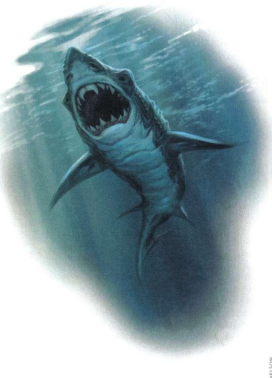Let's Read the 4e Monster Manual 2: Shark

This article is part of a series! Click here to see the rest.
Sharks are are real-world animals, and this Monster Manual 2 entry is their debut on D&D Fourth Edition. The Sahuagin entry from the first Monster Manual mentioned them a lot but that book didn’t have shark stats. The Monster Vault did have them, and we already looked at its take on sharks in the post linked above.
There are many species of real-world sharks, with very varied looks and behavior. Rather than worry about any of that, the Monster Manual 2 gives us a fantastic species based on our worst fears about sharks. Witness the horrible might of the Fleshtearer Shark, the bullete of the sea!
The Lore
Fleshtearer sharks seem to be kinda modeled on the shark from Jaws. They’re big, they’re stupid, they’ll try to eat anything they can bite, and that can include boats. These sharks can thrive anywhere, I do mean anywhere: not only can you find them in oceans of any temperature, they sometimes live in rivers and lakes and even swim in the Underdark.
Fleshtearers can live for hundreds of years and never stop growing, which can make those subterranean sharks even larger and stronger than the typical specimen presented in this entry.
Sahuagin and kuo-toa usually steer clear of fleshtearer sharks because they’re too dangerous to tame, but sometimes a heroic trainer among them will manage the feat. In this case, the “tame” flesh-tearer is used in raids against large ships, eating anyone who falls overboard and biting holes in the hull.
The Numbers
Fleshtearer sharks are Large Natural Beasts with the Aquatic keyword. They’re Level 10 Brutes with 128 HP and low-light vision. They swim at speed 8, but can only flop around at speed 1 on land.
The Aquatic keyword gives the shark a +2 attack bonus against non-aquatic opponents when both are in water, and it also has a custom Waterborne trait that stacks a +2 damage bonus on top of that.
Their basic attack is of course a Bite, but they also have several special maneuvers. Lockjaw Charge is a charge attack that also grabs the target. Grabbed targets are vulnerable to the shark’s shredding teeth, which always hit and deal heavy damage.
The shark has no special ability to pull a grabbed victim along when it moves, so it must use the standard rules for doing that (opposed Strength tests). It can also choose to stay in place while it chews into the victim with Shredding Teeth.
A fleshtearer shark will lurk out of detection range until it picks a target (the tastiest-looking PC). It will then use Lockjaw charge on them, relying on its toughness to weather any opportunity attacks. It will probably release the grab and swim away for another pass rather than getting pinned down by the other PCs, but it’s too obstinate to run and usually fights to the death.
The shark’s bloodlust often gets in the way of those tactics, which is represented by a trait named Feeding Frenzy. When the shark starts its turn within 5 squares of a bloodied creature, it must make a bite attack against a creature adjacent to itself, which will also make it release a grabbed victim if it has one. “Creature” here means both allies and enemies can trigger the effect and be valid targets for the bite attack. Even a “tame” shark is dangerous to its allies.
Sample Encounters and Final Impressions
It’s a movie shark, doing movie shark things. If you’re adventuring on or under water, you might run into it, otherwise it won’t usually impact your adventuring life.
You can make them Huge and level them up to represent Underdark sharks, in which case they might make good thralls for Aboleths and for Mind Flayers who want to fight Aboleths.
We get one sample encounter here:
- Level 10: 2 fleshtearer sharks, 1 sahuagin baron, 2 sahuagin priests. This is likely the “command squad” for a bigger raid against a large ship or coastal village. They’d stay a bit further away from the front lines, and engaging them might be necessary to end the raid.